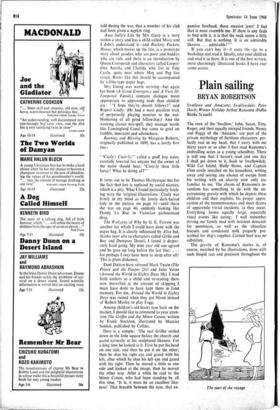Plain sailing
BRYAN ROBERTSON
The crew of the 'Swallow,' John, Susan, Titty, Roger, and their equally intrepid friends, Nancy and Peggy of the 'Amazon,' are part of the private mythology of fictitious characters, per- fectly real in my head, that I carry with me thirty years or so after I first read Ransome's enthralling series as a young schoolboy. There is still one that I haven't read and one day I shall get down to it, back to Swallowdale, Wild Cat Island, Holly Howe, and Captain Flint cosily installed on his houseboat, writing away and seizing any chance of escape from his writing with an alacrity now only too familiar to me. The charm of Ransome's in- ventions has something to do with the un- patronising gravity with which he depicts these children and their exploits, his proper appre- ciation of the momentousness and sheer drama of apparently trivial incidents, as they occur. Everything looms equally large, especially ritual events Ike eating: I well remember driving my family mad with insistent demands for pemmican, as well as the chocolate biscuits and condensed milk properly pre- scribed for ship's supplies. Corned beef was no substitute.
The gravity of Ransome's stories is, of course, matched by his illustrations, done with such limpid tact and precision throughout the
The start of the voyage text. What a power to suggest the unblemished flow of days and nights in the holidays theie Ransome drawings have. Swimming in the lagoon, diving for the anchor, getting your trousers darned while still wearing them (Roger, of course), setting up camp, having breakfast on the way, being seasick, finding the treasure—these delicately robust line- drawings of a small sailing dinghy cruising on placid waters, with mysterious, densely wooded banks in the distance and high mountains coming down to the water's edge, are all too much for me in this unsettling June weather with holidays vaguely ahead. Why do Ran- some's drawings have such an evocative power, as well as such sturdy resilience in the face of age or time?
One reason I have already suggested : their explicit nature with nothing fuzzed over or left vague. Another reason is their extreme concentration—the way in which children con- centrate, when sufficiently roused—on factual evidence of actual events, not just dim states of mind or atmosphere. Next, they depict exactly what the simple caption suggests, no less and no more, and (this is terribly impor- tant if you are an inquisitive child, constantly wanting to check the state of play) both draw- ings and captions mirror a specific sentence or paragraph in the text near by. It is dis- appointing when young to see an interesting drawing with highly circumstantial detail that is nowhere embodied in the relevant text, or even referred to : vague correspondences are not enough. Ransome always plays fair. Two more reasons for their success: the drawings of these children and their eminently believable adventures always disclose a particularised con- text, a landscape, waking up on board ship or whatever, but the children are invariably small in outline, generalised, often seen from behind and from afar, with no faces visible. They are therefore credible within these exactly realised settings, but sufficiently vague for every reader to be able to project himself into that boy's or girl's shape. Ransome was a wily bird.
Last of all, the drawings, with all their charm and sense of occasion, have faintly the sug- gestion of children's drawings, made by very superior children. The slightest patronising whiff of faux naïf would render them suspect in a trice to any self-respecting boy or girl, but Ransome has an abstract sense of space, and the courage to use it to advantage; and there are, surprisingly, enough deft obeisances to the requisites of serious art to remove his drawings from any false area of children's art—though so many of them are distinctly childlike in their beady-eyed, wobbly charm. The maps are especially full of this: so elaborately explanatory and direct, and so utterly barmy as cartography. I suspect that Ransome learned more than he let on from those early years spent in Russia, where book illustration, graphic art, woodcuts in particular, and the modern spirit, came together with con- spicuous success around the turn of the century, just up to the revolution.











































 Previous page
Previous page